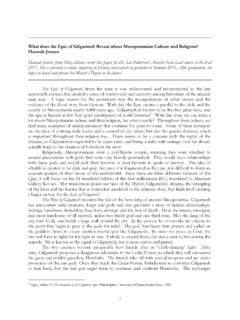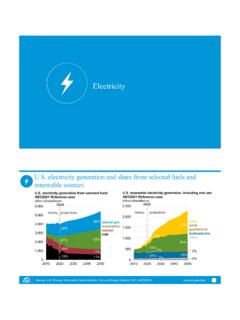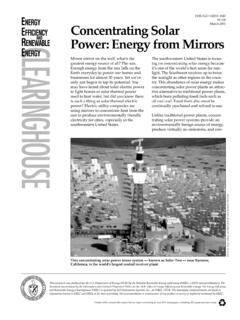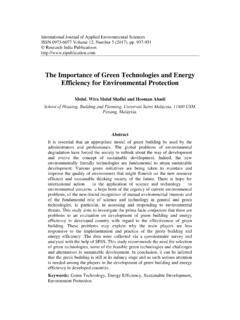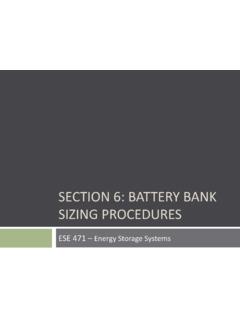Transcription of Design Methodology of Off-Grid PV Solar Powered System (A ...
1 Design Methodology of Off-Grid PV Solar Powered System (A Case Study of Solar Powered Bus Shelter) Author: Ayaz A. Khamisani Advisors: Dr. Peter Ping Liu, Dr. Jerry Cloward, Dr. Rendong Bai Design Methodology OF OFF GRID Solar SYSTEMS 2 Table of content Page List of figures 03 Abstract 04 Introduction 05 photovoltaic Cells 06 Working Principle of Solar Panels 07 Principle 07 Types of PV Systems 08 Standalone or Off-Grid Systems 09 Integrated or Grid-Tied System 10 Methodology of Designing an Off-Grid PV System 10 Site assessment 11 Shed analysis 11 Sun Hour 11 Tilt Angle 12 Energy Calculations 13 Panel Sizing 13 Battery Sizing 14 Invertor 14 Charge Controller 15 Proposal to Convert 7th Street Bus stand into a Standalone PV System .
2 16 Site Assessment 17 Calculating Energy Usage 18 Calculate Wattage of the Solar Panels 19 Battery Sizing 19 Invertor Sizing 20 Charge Controller Sizing 20 Conclusion 20 Reference 22 Design Methodology OF OFF GRID Solar SYSTEMS 3 List of figures Page 1. Figure 1 working of Solar cell: 08 2. Figure 2 Off-Grid Solar PV System 09 3. Figure 3 Grid-tied PV System 10 4. Figure 4 Sun hours across US 12 5. Figure 5 7th street existing bus shelter 17 6. Figure 6 CAD representation of the shelter 18 Design Methodology OF OFF GRID Solar SYSTEMS 4 Abstract Solar energy has incredible potential to power our daily lives.
3 Researchers suggest that the amount of sunlight that strikes the Earth's surface in an hour and a half is enough to handle the entire world's energy consumption for a full year. Solar power System is one of the best renewable energy technology which is not only cost effective but environment friendly as well. For my research, I have suggested methodologies that may be applicable to other off grid applications. I will be explaining Design Methodology using an example of an Off-Grid bus shelter. Off-Grid or standalone systems can be defined as independent systems that are not connected to any electrical grid. These come in different sizes and are mostly used in location where there is little access to grid infrastructure.
4 The Off-Grid bus shelter project will completely depend on the Solar energy Solar photovoltaics will harvest electricity to supply the devices such as lighting LED, Wi-Fi router and advertising billboard. A battery backup would be used as a continuous power supply in case of the worst weather. This paper will focus on how Methodology of off grid systems/ stand - alone systems can help to reduce the dependency of grid and allow us to live in self-sufficient manners without reliance on one or more public utilities. Further, a PV System will be designed for a bus shelter at EIU to demonstrate the concept. Design Methodology OF OFF GRID Solar SYSTEMS 5 Introduction Energy is a necessity like food and water.
5 Everything around us requires energy. Over the years there has been an increase in the earth s population which is directly proportional to the energy used as well. All the possible gadgets and equipment need some or the other kind of energy to function. With depleting fossil fuel reserves it becomes necessary to identify viable renewable energy resources that can decrease the dependency on fossil fuels. Solar energy is the most abundant form of energy available to us. It is approximated that 10000 TW worth of Solar energy is incident on earth s surface in a day (Bosshard, 2006). According to a report, the world energy consumption in 2015 was TW altogether (Seger, 2016). There has been a minimal increase in the energy consumption every year, approximately annual growth.
6 The world s total energy consumption is expected to grow by 56% by the year 2040 ( Energy Information Administration, 2013). Comparing current consumption, projected growth in two decades, and the amount of Solar radiation received in an hour we can just imagine the potential Solar energy holds. The total energy consumed is not small fraction of what we receive in an hour. Despite this energy potential available to us the current utilization of Solar energy is less than 5% globally. There are countries that are taking initiatives to switch from using fossil fuels to Solar applications. These countries form a pool called the G-20 countries which have taken the global leadership to adopt renewable resources of energy.
7 Germany is one of the G-20 countries that has switched its energy needs to approximately 38% to Solar , and aims to go completely stop its dependency on nuclear and replace it with Solar by the year 2050 (Richardson, 2017). Similarly, most of the countries have abundant Solar potential and can take a lesson from Germany. Design Methodology OF OFF GRID Solar SYSTEMS 6 Apart from harvesting the resource and decreasing the dependency on fossil fuel because they are limited, one must understand the consequences of using fossil fuels. Burning of fossil fuels for energy has an adverse effect on the environment. It releases CO into the atmosphere which is responsible for the greenhouse effect.
8 Further, it also causes the ozone layer to be depleted. These mentioned phenomena can cause several events to occur such as; acid rain, air pollution, land pollution because of excavating operations, etc. A 4 KW Solar panel used in homes for 25 years can offset 199,697 lbs of CO , is equivalent to planting, and is equal to 208,166 (RGS- Rethink your roof, ). It is fascinating that how much just one home can make an impact in the environment by using Solar panels. One could imagine, what would be the benefit of using this technology on larger scale. photovoltaic Cells In the 18th century, Swiss physicists assembled a warm trap, which was a small-scale greenhouse. He developed a hot box, by a glass box in another larger glass box, a total of up to five boxes.
9 When they are proposed to coordinate the sun illumination, the temperature in the deepest box can be raised to 108 degrees Celsius; warm enough to soak water and cook food. These crates can be considered the world's first Solar collection. In the late 1950, some organizations and research facilities began to create a silicon based Solar cell that considers the goal of controlling Earth-orbiting satellites. These include RCA, Hoffman Electronics, and in addition, the Army Alert Corps (Desideri, Zapparelli, & Garroni, 2013). A Solar cell, or photovoltaic cell, is an electrical device that converts the energy of photons that are incident on it to electrical energy, which is a natural and synthetic marvel.
10 A separate cell unit can be connected to a frame module, also known as a Solar panel. Different Solar cells in a unified set, all arranged in the plane represents a Solar photovoltaic board or Design Methodology OF OFF GRID Solar SYSTEMS 7 module. PV modules usually have a glass in front of the panel, allowing light to pass through, while ensuring that the semiconductor plate is protected inside the case. Solar cells are usually associated, and arranged in series or parallel module, depending upon the requirement of the customer. The parallel interface unit gets higher current; however, the problem, for example, that shadow effects can turn off weaker (less bright) parallel strings (different permutations of cells) can cause great unpleasant effects and may cause damage because of their enlightened complicity and the reversal of dark cell tendencies.









